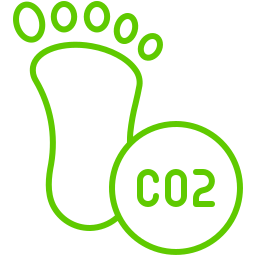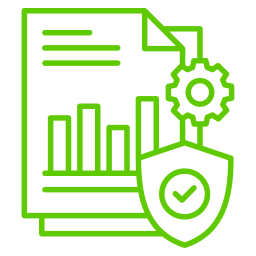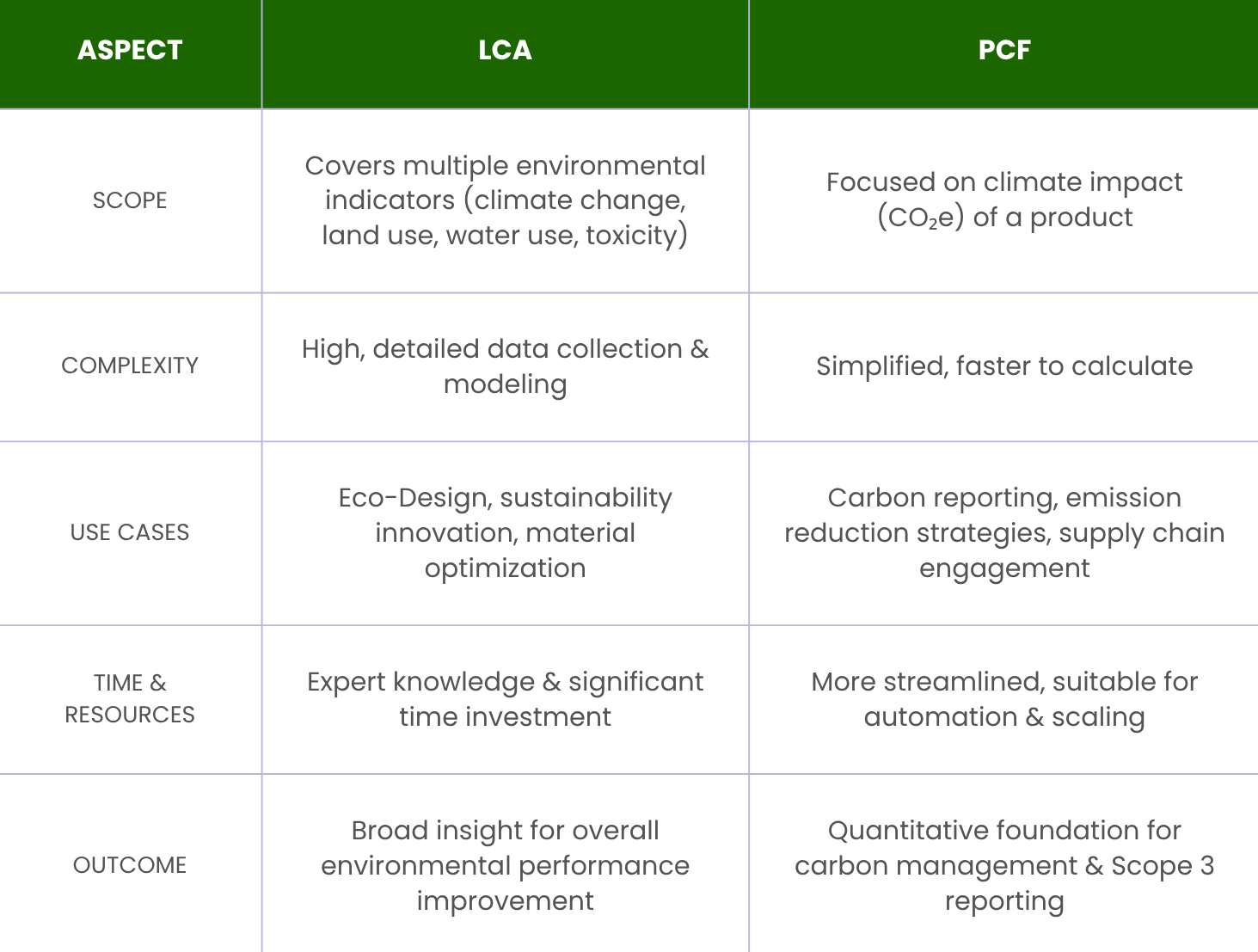LCA vs. PCF Differentiation: Life Cycle Assessment vs. Product Carbon Footprint
Understanding the difference between LCA (Life Cycle Assessment) and PCF (Product Carbon Footprint) is essential for companies aiming to meet rising sustainability and reporting demands. While an LCA provides a complete picture of a product’s environmental impact, a PCF delivers product-specific CO₂e data, enabling targeted carbon reduction, accurate Scope 3 reporting, and CSRD-compliant disclosures.


What Is a Life Cycle Assessment (LCA)?
A Life Cycle Assessment (LCA) analyzes the environmental impact of a product or service across all life cycle stages — from raw material extraction to production, use, and disposal. It includes multiple environmental indicators such as climate change, ozone depletion, land use and resource depletion or human and ecosystem toxicity. LCAs help companies create sustainable product strategies and identify impact hotspots across supply chains.




What Is a Product Carbon Footprint (PCF)?
A Product Carbon Footprint (PCF) focuses on a product’s climate impact by quantifying all greenhouse gas emissions (GHG) generated throughout its entire life cycle. Using the same methodological foundation as an LCA but limited to CO₂e emissions, the PCF records and calculates both the potential and actual environmental impacts that occur from manufacturing to use and disposal, offering a precise, climate-focused assessment of a product’s footprint.
PCF can be calculated for different life cycle scopes:
• Cradle-to-gate: from raw materials to the end of production gate.
• Cradle-to-grave: covering the entire product life cycle, including use and disposal.
PCFs are the foundation for Scope 3 emissions reporting, CBAM compliance, and CSRD disclosures, providing a clear, data-based starting point for climate action.



Life Cycle Assessment (LCA)
Assessed Impacts and Advantages
• Comprehensive inventory data evaluating multiple environmental impact categories across the entire product life cycle.
• Includes climate change, land use, and resource depletion.
• Provides a holistic view of sustainability performance beyond carbon emissions.
• Offers a comprehensive sustainability analysis covering all major environmental impact categories.
• Enables detailed benchmarking, hotspot identification, and life cycle optimization.

Product Carbon Footprint (PCF)
Assessed Impacts and Advantages
• Focuses exclusively on the climate impact of a product, using data related to energy use, materials, logistics, and end-of-life.
• Quantifies greenhouse gas (GHG) emissions expressed as CO₂e (carbon dioxide equivalents).
• Enables clear measurement and communication of a product’s carbon footprint.
• Provides a clear, climate-focused assessment with lower complexity and aligned directly with regulations like CSRD & CBAM.
• Delivers actionable insights for carbon reduction strategies and product-level transparency.

Standards and Methodology of LCA
• Based on internationally recognized standards ISO 14040, ISO 14044, and PAS 2050.
• Follows a structured four-phase approach: goal and scope definition, inventory analysis, impact assessment, and interpretation.

Standards and Methodology of PCF
• Uses the same methodological foundation as LCA but limited to climate-relevant emissions.
• Aligned with ISO 14040, ISO 14044, ISO 14067, GHG Protocol Product Standard, and PAS 2050.
• Designed for standardized carbon reporting and comparability across supply chains.
PCF vs. LCA
D
A Life Cycle Assessment (LCA) takes a broad, multi-impact view of sustainability, covering diverse environmental indicators across the entire product life cycle. In contrast, a Product Carbon Footprint (PCF) focuses specifically on CO₂e emissions of a product or material, providing a targeted, climate-related metric that supports carbon footprint reporting, Scope 3 calculations, and CSRD compliance.
Both methods rely on high-quality emission data to ensure accurate results.

Sustamize’s Approach: Turning LCA and PCF Data into Action
At sustamize, our focus is on making Product Carbon Footprints (PCFs) accessible, scalable, and reliable for every company.
While Life Cycle Assessments (LCAs) provide the scientific foundation, our technology translates these complex methodologies into automated, product-level PCF calculations, enabling organizations to understand, manage, and reduce their carbon footprints across entire product portfolios and supply chains. Through the sustamize reference database with more than 7 million verified emission factors, businesses gain access to high-quality, standardized CO₂e data that supports Scope 3 reporting, CSRD compliance, and climate action planning.
Instead of lengthy, manual processes, sustamize turns LCA complexity into actionable, automated carbon intelligence, helping companies make data-driven sustainability decisions faster and with confidence.
Which Method Should You Choose?
• Choose PCF to start measuring and managing your product-level CO₂e emissions quickly and efficiently.
• Choose LCA to expand beyond carbon and include broader environmental impacts once your data infrastructure is ready.
With sustamize’s smart data tools, you can easily start with PCF and scale toward full LCA-based sustainability insights.


Why Sustamize? Our Unique Value
Sustamize empowers organizations to build trust in their carbon data through automation, verified emission factors, and seamless integration. We simplify complex LCA and PCF processes into clear, scalable solutions for carbon footprint management and Scope 3 transparency. With sustamize, companies move from measurement to action - achieving real, data-backed sustainability progress.

Verified Data Quality
All emission factors are aligned with ISO 14067 and GHG Protocol standards. Our data undergoes biannual review, validation, and updates to ensure maximum accuracy and transparency.
Automated Integration
Sustamize connects carbon data directly to your ERP, PLM, or reporting systems, minimizing manual effort and ensuring consistent data use across departments and processes.

Scalable PCF Solutions
From single product carbon footprints to global supply chain analyses, sustamize helps to operationalize sustainability, accelerate reporting, & drive decarbonization at scale.

Do You Know Your Product’s Carbon Footprint?
Measuring the PCF of your materials and products is essential for transparent, compliant, and data-driven sustainability strategies. With precise product-level data, you can make informed decisions, reduce emissions, and communicate your carbon footprint with confidence.

Are You Aware of Your Product’s Life Cycle Assessment (LCA)?
Understanding your LCA is key to identifying environmental impacts across your product’s entire life cycle, from raw material extraction to end-of-life. With accurate and transparent LCA data, companies can not only meet sustainability and Scope 3 reporting requirements but also optimize their products for long-term environmental performance.

How Sustamize Helps You Scale Product Carbon Footprints?
Sustamize bridges the gap between LCA and PCF methodologies by transforming complex sustainability data into automated, product-level insights. With access to over 7 million verified emission factors, our platform enables precise CO₂e calculations, seamless Scope 3 reporting, and scalable carbon footprint management.


